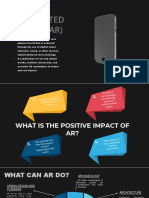0% found this document useful (0 votes)
19 views2 pagesINDEX
This document provides an overview of the history and future of augmented reality (AR) technology. It details the origins of AR dating back to 1968 with Ivan Sutherland's "Sword of Damocles" prototype. Significant developments occurred throughout the 1990s, with AR gaining popularity through applications in gaming, education, healthcare, manufacturing and more. Today, powerful smartphones and AR glasses are pushing the technology forward with diverse applications. The future of AR is promising, with the potential to reshape how people interact with and experience the world through enhanced education, immersive entertainment, and integration into daily life.
Uploaded by
mahekshobhasana721Copyright
© © All Rights Reserved
We take content rights seriously. If you suspect this is your content, claim it here.
Available Formats
Download as DOC, PDF, TXT or read online on Scribd
0% found this document useful (0 votes)
19 views2 pagesINDEX
This document provides an overview of the history and future of augmented reality (AR) technology. It details the origins of AR dating back to 1968 with Ivan Sutherland's "Sword of Damocles" prototype. Significant developments occurred throughout the 1990s, with AR gaining popularity through applications in gaming, education, healthcare, manufacturing and more. Today, powerful smartphones and AR glasses are pushing the technology forward with diverse applications. The future of AR is promising, with the potential to reshape how people interact with and experience the world through enhanced education, immersive entertainment, and integration into daily life.
Uploaded by
mahekshobhasana721Copyright
© © All Rights Reserved
We take content rights seriously. If you suspect this is your content, claim it here.
Available Formats
Download as DOC, PDF, TXT or read online on Scribd
/ 2






















































































